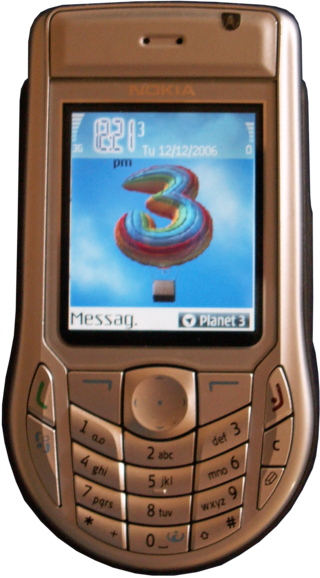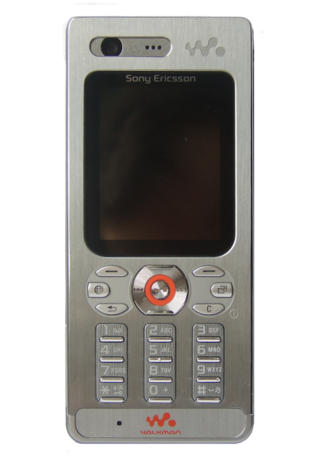The Universal Mobile Telecommunications System (UMTS) is a third generation mobile cellular system for networks based on the GSM standard. Developed and maintained by the 3GPP, UMTS is a component of the International Telecommunication Union IMT-2000 standard set and compares with the CDMA2000 standard set for networks based on the competing cdmaOne technology. UMTS uses wideband code-division multiple access (W-CDMA) radio access technology to offer greater spectral efficiency and bandwidth to mobile network operators.

A smartphone is a portable computer device that combines mobile telephone functions and computing functions into one unit. They are distinguished from older-design feature phones by their stronger hardware capabilities and extensive mobile operating systems, which facilitate wider software, access to the internet, and multimedia functionality, alongside core phone functions such as voice calls and text messaging. Smartphones typically contain a number of metal–oxide–semiconductor (MOS) integrated circuit (IC) chips, include various sensors that can be leveraged by pre-installed and third-party software, and support wireless communication protocols. More recently, smartphone manufacturers have begun to integrate satellite messaging connectivity and satellite emergency services into devices for use in remote regions where there is no reliable cellular network.

NTT DoCoMo's i-mode is a mobile internet service popular in Japan. Unlike Wireless Application Protocols, i-mode encompasses a wider variety of internet standards, including web access, e-mail, and the packet-switched network that delivers the data. i-mode users also have access to other various services such as: sports results, weather forecasts, games, financial services, and ticket booking. Content is provided by specialised services, typically from the mobile carrier, which allows them to have tighter control over billing.

In Japan, mobile phones became ubiquitous years before the phenomenon spread worldwide. In Japanese, mobile phones are called keitai denwa (携帯電話), literally "portable telephones," and are often known simply as keitai (携帯).

Vodafone live! was the brand name for the multimedia portal service of mobile phone operator Vodafone, offering news content, picture messaging, instant messaging, email, and downloadable ringtones and games. The service officially launched on 24 October 2002, originally in eight countries. The first compatible phones were the Japanese Sharp GX10 and Panasonic GD87, and the Nokia 7650.
GSM frequency bands or frequency ranges are the cellular frequencies designated by the ITU for the operation of GSM mobile phones and other mobile devices.

The Nokia 6630 is a 3G smartphone announced by Nokia on 14 June 2004 and released in November. It runs on Symbian OS 8.0a. Codenamed Charlie during development, it is an evolution of the 6600 and 6620 smartphones, supporting tri-band GSM.
Sony Ericsson Z800i is a 3G mobile phone developed by Sony Ericsson and released in 2005. The Z800i is a phone that is identical to the Vodafone branded Sony Ericsson V800.

The Sony Ericsson V800 is a mobile phone manufactured by the Japanese-Swedish firm Sony Ericsson and released in late 2004. It is no longer available on the market. The V800 was available in three colors, Black, White and Copper.
LISMO is an online music service provided by au, a Japanese mobile phone brand run by KDDI, a Japanese telecommunication company. This service uses a mobile phone as a music player. This service was introduced on January 19, 2006, and the service began operating at the end of January in Japan. The first mobile phone which supports LISMO was sold on January 26, 2006. Since 2008, KDDI and Okinawa Cellular introduced 'LISMO Video', a new service with new means to enjoy video content as well.
Safaricom PLC is a listed Kenyan mobile network operator headquartered at Safaricom House in Nairobi, Kenya. It is the largest telecommunications provider in Kenya, and one of the most profitable companies in the East and Central Africa region. The company offers mobile telephony, mobile money transfer, consumer electronics, ecommerce, cloud computing, data, music streaming, and fibre optic services. It is most renowned as the home of MPESA, a mobile banking SMS-based service.

The HTC TyTN is an Internet-enabled Windows Mobile Pocket PC PDA designed and marketed by High Tech Computer Corporation of Taiwan. It has a touchscreen with a left-side slide-out QWERTY keyboard. The TyTN's functions include those of a camera phone and a portable media player in addition to text messaging and multimedia messaging. It also offers Internet services including e-mail, instant messaging, web browsing, and local Wi-Fi connectivity. It is a quad-band GSM phone with GPRS, and EDGE, and a single/dual band UMTS phone with HSDPA. It is a part of the first line of PDAs directly marketed and sold by HTC. On AT&T/Cingular, the TyTN was the successor to the HTC Wizard, known as the Cingular 8125. Also on AT&T, the TyTN was superseded by the HTC TyTN II, known as the AT&T 8925 and the AT&T Tilt.

In telecommunications, a femtocell is a small, low-power cellular base station, typically designed for use in a home or small business. A broader term which is more widespread in the industry is small cell, with femtocell as a subset. It connects to the service provider's network via broadband ; current designs typically support four to eight simultaneously active mobile phones in a residential setting depending on version number and femtocell hardware, and eight to sixteen mobile phones in enterprise settings. A femtocell allows service providers to extend service coverage indoors or at the cell edge, especially where access would otherwise be limited or unavailable. Although much attention is focused on WCDMA, the concept is applicable to all standards, including GSM, CDMA2000, TD-SCDMA, WiMAX and LTE solutions.

The BlackBerry Pearl was a series of smartphones developed by Research In Motion, and was the first BlackBerry device with a camera and media player. It was originally released on September 12, 2006. T-Mobile was the first US carrier to release the phone as a carrier device. The last BlackBerry Pearl released was the 9100 series on May 13, 2010. After this model was cleared out, RIM discontinued the Pearl series.

The Sony Ericsson W880i is a mobile phone that was announced on 6 February 2007 and released in spring 2007. Part of Sony Ericsson's Walkman series, the phone has been popular due to its tiny dimensions and low weight. At only 9.4 mm thick, the W880 was one of the few phones on the market that were thinner than 1 cm (10 mm), the other notable example being the Nokia 5310 XpressMusic from later that year.

The HTC TyTN II is an Internet-enabled Windows Mobile Pocket PC smartphone designed and marketed by HTC Corporation of Taiwan. It has a tilting touchscreen with a right-side slide-out QWERTY keyboard. The TyTN II's functions include those of a camera phone and a portable media player in addition to text messaging and multimedia messaging. It also offers Internet services including e-mail, instant messaging, web browsing, and local Wi-Fi connectivity. It is a quad-band GSM phone with GPRS, EDGE, UMTS, HSDPA, and HSUPA.
The Toshiba 902T was a 3G cellphone made by Toshiba in 2005, and was sold under Vodafone Japan. It's a variant of worldwide version TS921, that featured a 1.92-megapixel camera, a QVGA screen, a Bluetooth device, and "Active Turn Style" two-rotation axes display design.

HTC Magic is an Android smartphone designed and manufactured by HTC. It is HTC's second Android phone after HTC Dream, HTC's first touch-only flagship Android device and the second Android phone commercially released, as well as the first Android phone without a keyboard.
The Toshiba TG01 is a large touchscreen phone/Mobile Internet Device. It is based on the Windows Mobile operating system and uses Qualcomm Snapdragon chip architecture (QSD8250), rated at 1GHz. Connectivity-wise, it is a quad-band GSM phone with support for 2100 MHz UMTS with HSDPA download speeds of up to 7.2 Mbit/s and HSUPA upload speeds of up to 2 Mbit/s. It is Wi-Fi capable, GPS-enabled with support for A-GPS, and comes with Bluetooth 2.0, microSD expandable memory and a micro USB connector.












